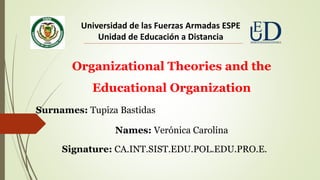
A2.tupiza.veronica ca.int.sist.edu.pol.edu.pro.e.
- 1. Organizational Theories and the Educational Organization Surnames: Tupiza Bastidas Names: Verónica Carolina Signature: CA.INT.SIST.EDU.POL.EDU.PRO.E. Universidad de las Fuerzas Armadas ESPE Unidad de Educación a Distancia
- 2. ORGANIZATIONAL THEORY AND THE EDUCATIONAL ORGANIZATION INSTITUTIONAL THEORY This theory says us that the organizations changes to be similar. Institutions consist of cognitive, normative, and regulative structures and activities that provide stability and meaning to social behavior. The theory explains why some organizations take the form to they do and why they are considered legitimate institutions. The cognitive pillar involves symbols, beliefs and social identities. The schools obtain legitimacy like other organizations do: through regulative, normative and cognitive processes. The isomorphism of colleges and universities can be tracked to the three main forms: Coercive isomorphism happens because of regulations, such as requirements for accreditation. Mimetic isomorphism occurs when schools copy each other. Normative isomorphism comes about from the same people moving from school to school or, for instance, when all doctoral students are taught the same way, as professors, they bring the same teaching styles with them to their classrooms. INSTITUTIONAL THEORY AND THE UNIVERSITY
- 3. POPULATION ECOLOGY Population ecologists on the other hand think that the environment determines the opportunities of success or failure for organizations. Baum (1996) categorizes these processes of determinism into three sets: 1. Demographic processes, which include age dependence 2. Ecological processes, which include niche width dynamics 3. Environ mental processes, which include institutional factors RESOURCE DEPENDENCY THEORY It focuses on environmentally driven aspects of organizations. it is believed that organizations change their goals to meet the available resources. Resource Dependency and the Educational Environment The environment of higher education organizations is rapidly changing. The students are a scarce resource and universities are faced with pressure to manipulate the environment in order to attract more students.
- 4. A NEW MODEL FOR CLASSROOM STRUCTURES The structural contingency theory, focuses on how organizations determine which organizational structure to take. There are five structures of Mintzberg that serve as base, they will examine the capacity to meet various contingencies. ORGANIZATIONAL STRUCTURE According to Hall (1999), the organizational structure is divided into three variables: Formality, complexity and centralization. The formality is measured by the rules written in an organization and implies "organizational control over the individual. The complexity it is measured by the "division of labor, job titles, multiple divisions and Hierarchical levels. The centralization refers to the distribution of the power into the organizations.
- 5. STRUCTURAL CONTINGENCY THEORY There is no single and effective structure for all organizations, they have to adpt to their structures to the factors contingency factors and the enviroment as they affect the organization. Contingency factors can include: strategy, size, task uncertainty, parent organization, public accountability, critical assets and technology Donaldson offers an explanation of the cycle with his SARFIT (structural adaptation to regain fit) model (Donaldson 1995; Donaldson 1996). The stages of this model are: 1. An organization is in fit. 2. There is a contingency change. 3. The organization is in misfit and performance suffers 4. The organization does structural adaptation. 5. The organization achieves a new fit and performance recovers.
- 6. THE CLASSROOM AND ITS CONTINGENCIES These contingencies include: 1. The learning objectives. 2. The cognitive domains they hope to obtain. 3. The technology they will use. 4. The assessment techniques (Rueter & Perrin 1998). Finally, they must determine which classroom structure will fit with these considerations. THE CLASSROOM AND ITS STRUCTURE Modeling Mintzberg’s classification, there are five types of classroom structures: • Tradicional structure • Star Structure • Cicular Structure • Flat Structure • Complex Structure
- 7. The traditional structure, based on Mintzberg’s Machine Bureaucracy because of its hierarchical nature, is probably the most common classroom structure. The star structure is one in which the student is the focus of the activity. This structure is based on Mintzberg’s Professional Bureaucracy because while it is complex, it is also stable, since everyone relies on everyone else for knowledge. A circular structure, based on Mintzberg’s Simple Structure because of its centralized and organic nature, is one in which the learner draws on a circle of knowledge sources, including other students, teachers, real-life experiences and observation. The flat structure, based on Mintzberg’s Divisionalized Form because of its focus on specialization and autonomy. The student is solely responsible for her learning through independent research. The complex structure and is based on Mintzberg’s Adhocracy because of its complex and dynamic nature. The complex structure can be a combination of any or all of the first four structures.
- 8. A NEW MODEL: THE CLASSROOM AND STRUCTURAL CONTINGENCY THEORY When deciding how to structure their classrooms, instructors must consider contingencies. the traditional structure fits best with fields that are based on facts or knowledge, such as the physical sciences. This structure is also suited to technologies that rely on the instructor sharing knowledge with students, such as lectures and multimedia presentations. The star structure is better suited to fields that rely on learning through doing, discussing or experiencing, such as the social sciences or humanities. The star structure, relying on individual students and the instructor sharing their knowledge and understanding of an area, allows subtlties to become more evident. The circular structure can be applied to almost any field because of its loose nature, relying on a variety of technologies and achieving a collection of cognitive levels. Because the flat structure is so similar to the circular structure in levels of formality, complexity and centralization, only lacking a class with which to share learning experiences, it too can be widely applied across fields.
